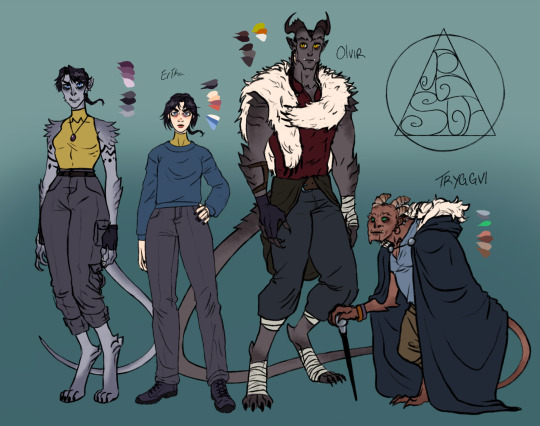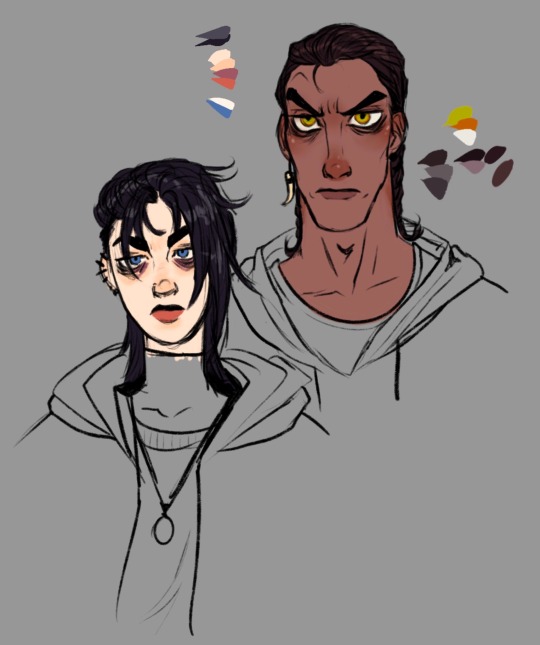#tryggvi
Explore tagged Tumblr posts
Text
heres some gay aloth slowburn if anyone wants some food
#pillars of eternity#male watcher#the watcher#aloth corfiser#my writing#i guess thats a tag now#anyway#tryggvi
20 notes
·
View notes
Text


Finally named them and finished their lineup! Very happy with how they turned out and looking forward to doing more! Still working on lore, but i’ll submit a post once that’s more concrete. :)
16 notes
·
View notes
Text
youtube
Matthías and Klemens's Patreon show has a free episode up featuring Einar where they talk about their journey with Hatari! Lots of fun, juicy stuff here, including a snippet of a demo which I'm of course going to transcribe and translate.
40 notes
·
View notes
Text
While I'm at it, here are my favorite illustrations from Browne's work


Baldr and Thórr


Iðunn, and King Harald Fairhair's first battle


Nótt, and Sigurðr slaying Fáfnir


Freyja's mighty anger, Sigyn and Loki's plight

Frigg and Loki

Queen Astrid, fleeing after the treacherous slaying of her husband Tryggvi

Ólafr the Peacock meeting Myrkjartan, king of the Irish

The Valkyrjur, hail
#art#heathenry#my favorites#history#classic illustration#sagas#norse mythology#norse paganism#polytheism#spirituality#paganism#pagan#norse gods#norse myth#norse pantheon
117 notes
·
View notes
Text
Book: ...a former jarl's guard who openly admitted to being responsible for the threatening letter written to Theod and me. His name was Otrygg Otryggson.
Nimbler: *bursts into laughter*
Traitor McTraitorface? Really? That's what you named the fellow? No wonder you're not afraid to throw around names you're unlikely to use again!
(Tryggvi is an actual name - witness King Olaf Tryggvason - and ó- is a negative prefix. The verb involved is trúa, or the adjective tryggva, true/loyal/faithful. So this dude's name is uh. Hilarious.)
#Nimblermortal liveblogs#to shape a dragon's breath#it's things like this that have me on a real roller coaster of whether I enjoy this book or not
43 notes
·
View notes
Text

We’d like you to meet Kristján Atli Heimisson!❄️ Kristján is the voice of Sidja Group representative and family member Tryggvi Rúnuson. We so enjoy working with Kristján and hearing how he brings Tryggvi to our headphones! Thank you for joining us, Kristján! Text: Introducing Kristján Atli Heimisson as the voice of Tryggvi Rúnuson. Kristján is a Voice Actor from Iceland with a background in TTRPGs. His day job as an electrician allowed him to experience being a sound and light technician on shows like Grease, Perfect Wedding, and more. After years of playing and running tabletop games, he got a taste for voice acting and streaming, which he does regularly on Twitch. Welcome to The White Vault.
#audio drama#podcast#the white vault#fool and scholar#audio fiction#horror podcast#fiction podcast#voice acting
9 notes
·
View notes
Text
Fire Emblem Three Sagas
I've been playing through Banner Saga and wanted to do a study of the art style, so I drew Dimitri using the base of the spear-wielding characters from Banner Saga (I didn't realize until I was studying them that Ludin and Tryggvi. used ... the same base). It was a fun exercise, although I'm not 100% on the colors I picked for the lines! The background is just a screenshot I yoinked + blurred.

10 notes
·
View notes
Text
Thor (incomplete notes, expect edits)
Died seven winters after the Battle of Svolder (1x3)
...while "tracking beasts across the land" (ibid)
Norvegr (2x6)
Really hates "Danes"
Son married a "Danish" woman.
Died at age of 35 (2×14)
3 brothers, kin or fictive, fell in battle (2×16)
That's what we know.
Okay, so from what I'm reading on the Battle of Svolder (1000CE), these were the prominent figures:
Olaf Tryggvason ✝
Son of Tryggvi Olafsson, king of Viken (around Oslo) (Vingulmark, and Rånrike). Father was murdered, grew up in Orkney.
Long list of activities.
He took control of Norway in 995 CE.
Active promoter of Christianity in Norway, insisted vassals be baptized.
In 997, Olaf ✝ founded his seat of government in Trondheim, where he had first held a thing with the revolters against Haakon. It was a suitable site because the River Nid twisted itself before going into the fjord, creating a peninsula that could be easily defended against terrestrial attacks by only one short wall.
Olaf ✝ continued to promote Christianity throughout his reign. He baptized the explorer Leif Ericson ✝, who took a priest with him back to Greenland to convert the rest of his kin.[14] Olaf also converted the people and Earl of the Orkney Islands to Christianity.[15] At that time, the Orkney Islands were part of Norway.
It is only when Olaf Tryggvason ✝ sights Eirik Hákonarson's contingent that he realises he is in for a hard battle, because "they are Norwegians like us".
Eirik Hákonarson
Earl of Lade and son of Haakon Jarl.
Hákon Sigurðarson (Haakon Jarl) was a strong believer in the Old Norse gods, and when King Harald Bluetooth attempted to force Christianity upon him, Haakon broke his allegiance to Denmark. A Danish invasion force was defeated at the battle of Hjörungavágr in 986. According to Heimskringla, Eric, apparently reconciled with his father, commanded 60 ships in the battle and emerged victorious. After the battle he gave quarter to many of the Jomsvikings, including Vagn Ákason.
In 995, as Óláfr Tryggvason ✝ seized power as King of Norway, Eric was forced into exile in Sweden.
He allied himself with King Olof of Sweden and Sweyn ✝, the Christian king of the Danes, whose daughter, Gyða, he married. Using Sweden as his base he launched a series of raiding expeditions into the east.
Also needs to be considered: Haakon Jarl -
Haakon was a strong believer in the old Norse gods, even after Harald Bluetooth ✝ forced him to accept baptism around 975 and assigned him clergymen to take to Norway to spread Christianity. When a favourable wind came for Haakon to leave, he commanded the clergymen to return ashore,[4] and broke his allegiance to Denmark.
In 995, a quarrel broke out between Haakon and the Trønders just as Olaf Tryggvason ✝, a descendant of Harald Fairhair arrived. Haakon quickly lost all support, and was killed by his own slave and friend, Tormod Kark, while hiding in the pig sty in the farm Rimul in Melhus.
A number of (textually related) sources also recount Earl Haakon's predilection for raping women, whether the daughters of nobles or of commoners.
...It is clear that Svein Forkbeard ✝, Olaf the Swede and Eirik had ample reason to oppose Olaf Tryggvason ✝. Olaf had taken control of Viken in south Norway, an area long under Danish overlordship. Olaf and Svein had been in England together, but Olaf had made peace while Svein Forkbeard ✝ kept campaigning. Svein ✝ was on friendly terms with Olaf the Swede and connected to him by marriage, so the two were natural allies.[17] Finally, Jarl Eirik had been driven from his patrimony by Olaf Tryggvason ✝, as arguably had his father, Jarl Hakon, whom he may have wished to avenge.
In the Battle of Svolder in 1000, Eric, Sweyn, and Olof ambushed king Óláfr Tryggvason by the island of Svolder.
After the Battle of Svolder, the victorious leaders split Norway into areas of control. Heimskringla gives the most detailed account of the division, describing it as threefold. Olaf the Swede received four districts in Trondheim as well as Møre, Romsdal and Rånrike. He gave these to Jarl Svein Hákonarson, his son in law, to hold as a vassal. Svein Forkbeard ✝ gained possession of the Viken district, where Danish influence had long been strong. The rest of Norway was ruled by Eirik Hákonarson as Svein's vassal.[52] Fagrskinna, in contrast, says that the Swedish part consisted of Oppland and a part of Trondheim.
The Jarls Eirik and Svein proved strong, competent rulers, and their reign was prosperous. Most sources say that they adopted Christianity but allowed the people religious freedom, leading to a backlash against Christianity which undid much of Olaf Tryggvason's ✝ missionary work.
After Olaf's defeat at the Battle of Svolder in 1000 there was a partial return to paganism in Norway under the rule of the Jarls of Lade.
So. Prejudice against the Danes by Norwegians focuses on weakness in naval combat.
After spotting the enemy, Olaf might have used sail and oar to outrun the ambush and escape, but he refuses to flee and turns to give battle with the eleven ships immediately about him. Seeing the Danish fleet arrayed against him, he comments: "The forest goats will not overcome us, for the Danes have the courage of goats. We will not fear that force because the Danes have never carried off the victory if they fought on ships."
It is only when Olaf Tryggvason sights Eirik Hákonarson's contingent that he realises he is in for a hard battle, because "they are Norwegians like us".
The sagas give all the credit to the Norwegians, praising Eirik Hákonarson for any intelligence and for most of the valour shown by Olaf Tryggvason's opponents. The Danes and Swedes rush at the front of Olaf's line and are repulsed, suffering heavy casualties and loss of ships. Jarl Eirik attacks the flank and forces his vessel, the Iron Ram, up against the last ship of Olaf's line, which he clears with a fierce attack and then proceeds onto the next ship. In this way, Olaf's ships were cleared one by one, till the Long Serpent alone was left.
Thor's views of the Danes seem to jive more with a general prejudice of Danes by Norwegians.
With one exception, all of Norway's rulers since Håkon the Good (c. 920–961) were Christians (however Håkon later reverted to Heathenism as an apostate), as was Olaf's main opponent, Cnut the Great.
HOWEVER, his religion jives more with that of Haakon Jarl.
From the Norwegian wiki:
"Sigurd Ladejarl was hard to expose, and so was Håkon, his father. Sigurd held all the feasts on the king's behalf there in Trøndelag." [36] With this quotation, Snorri places the main seat of the old hill tribe precisely at Lade. Christianity was already well known in Norway at the time of Harald Hårfagre, and in the 9th century the new faith gained traction in parts of the population, but not in Trøndelag.
The Danish king, under strong pressure from the German-Roman emperor Otto II, had forced the earl to be baptized and sent priests with him to Norway. But as soon as Håkon was out of reach of the Danish king, he put the priests on shore and stood out as a complete heathen in the tradition of the Ladejarls. In the tribute quatrain Vellekla by the Icelandic bard Einar Skålaglam , earl Håkon is referred to as an advocate of the old religion, and he is considered among the last rulers in Norway to profess the Norse religion. According to Snorre, the earl is said to have declared himself a "Sæming" - that is, one of the sons of the warrior god Odin . "He should never seek out the fight, but also never shy away from the fight."
In Vellekla , Håkon is hailed as the one who brought åsatrua back to the Norwegians after the Christian kings Håkon the Good and Eirikssønnene: [37]
Wise Lord of the Army
let them ravage hofland
which Tor owned, again
regarded as temples of gods.
Even a Thor behind the shield
he led over the sea
to jotner's way of fighting
wolf. Him gods rule. [38]
Archaeologist Frans-Arne Stylegar nuances the image of the pagan Håkon by showing that during his raid in Gøtaland Håkon tore down and robbed a hoof that was dedicated to the god Thor . Odd Snorresson (Odd Munk) writes that Gautland earl Ottar had Håkon declared "varg i veum" (wolf in the sanctuary) at the court after the crime. [39]He also mentions that Harald of Denmark is said to have sent German missionaries to Norway. Håkon's role in this connection is unclear, but there are clear archaeological traces that indicate that Christianity gained a foothold in the country at this time. Stylegar claims that "the trend at this time was to fill political alliances and subordination relationships with Christian, ideological content. Such was the relationship between Emperor Otto and King Harald, and this may well have been the case between Harald and earl Håkon as well." [40] In other words, it is conceivable that earl Håkon became a Christian in his older days for purely political and opportune reasons.
A distinctive feature of earl Håkon's worship of the gods is the relationship with the goddess, the guardian spirit or the valkyrie Torgerd Holgebrud . Especially during the Battle of Hjørungavåg, she has a central role. Things went badly for Håkon at the beginning of the battle and he invoked his patron saint. She demanded a large sacrifice, and Håkon had his seven-year-old son Erling killed. The battle then turned and Håkon won with the help of Torgerd and her sister Irpa. Torgerd also has an important role in connection with Håkon's revenge on Torleiv Jarleskald. [41] [42] The cult around Torgerd is also known from Icelandic sources.
Thor, he's... probably early 30s???
Seven years after the Battle of Svolder, that would mean he'd have been in his early twenties then.
Usually, by the time you have a wife and child, you'd not be going off on that kind of long-range expedition. And seriously, that's long range. Norvegr to Iceland is about a week under ideal conditions, but using the easier island hopping route could take weeks, and 3 to 4 weeks from Norway to Greenland if they had a sunstone.
See:
It all depends on where they left from of course. Traditionally it was said that a journey from the west coast of Norway to Iceland would take about 7 days, while the journey from the west coast of Norway and over to Ireland would be about 3 days of sailing.
Despite the distance being almost the same as from Norway, the journey to Iceland was also said to be just 3 days journey from Dublin in Ireland, which was one of the major viking trading cities in Europe at the time. This was probably due to the favourable wind and currents along the gulf stream.
There was therefore much contact between Iceland and Dublin, especially for trade in valuable goods such as walrus ropes and walrus oils, both uniquely suited for ship-building and maintenance, which were difficult to acquire anywhere else than Iceland and far Siberia. On the return voyage the most valuable commodity brought was slaves, since the hunting and extraction of oil, skin and meat from walrusses were a tiresome job, but various farm animals, foodstuffs such as grains, as well as weapons and fine linens were also in high demand.
Sources and more details on the economics of viking age Iceland and Ireland can be found in "Den svarte vikingen" by Bergsveinn Birgisson.
However:
The journey from Greenland to the settlement in Vinland is more than 3000 km long and would likely have taken the Vikings a minimum of two weeks (and possibly even six weeks or longer) to complete, one-way.
Norway to Iceland: Half the sailing season (May to September). Iceland to Greenland: ???.
Traveling to Vinland would likely have taken at least two years. Thor had to have a reason to be absent for so long, and reason to think he was coming back.
My thought? Politics or religion. But maybe it was, simply, economics. Perhaps he was even trying to pave the way for his family.
Timeline
c. 982 - Erik the Red discovers Greenland for the Norse knowledge base.
c. 985 - Norse settlement of Greenland
986 - summer - Bjarni Herjólfsson relays sighting of hospitable lands to west of Greenland
995 - Haakon Jarl killed. In the chaos Olaf Tryggvasson ✝ takes over.
1000 - Leif Eriksson ✝ explores the land Bjarni described and overwinters.
999/1000 - September - Battle of Svolder. Olaf Tryggvasson ✝ killed. Christianizaion of Norway slowed due to Eirik Hákonarson and Svein Forkbeard permitting greater religious freedom.
999/1000 - First winter hence
1000/1001 - Second winter hence
1001/1002 - third winter hence
1002/1003 - fourth winter hence
1003/1004 - fifth winter hence
1004/1005 - sixth winter hence
1005/1006 - seventh winter hence.
1006/1007 - At this point Thor is killed by lightning. Light or lack of snow in scene suggests spring.
Key
To ease remembering who is allied with who, I'm going to mark Christianized Norse with this symbol ✝ following their names. 🔨 is for those who favored the Norse pantheon, and both are for those who are unidentified. Notation will be completed later.
9 notes
·
View notes
Text
Yvain -
It's good to hear from you. Seems like a constant of both of our days - too many things to say, never enough time to catch up.
I do have a story for you.
It doesn't come up so often anymore, but I earned my spurs out of the Convictory. I'll spare you the retelling of the banalities of daily existence there. It's enough to know that our visitors were few.
Michault de Vitroix was one such visitor. A dragoon in full kit was naturally the talk of the day he arrived. Just to winter over a day or so and catch up with some familiar faces - he was known to a few of the longer-term residents, even had a word with Ser Jantellot himself. He kept his conversations and company to that select circle, but the implications didn't escape anyone else: one of our own who had made it.
Until then, I'd never heard of anyone from that place actually making it anywhere.
The second day, Ser Michault entertained himself by challenging a few hopefuls, as we often challenged each other when things were slow. I can't quite forget the skill that he wielded his lance. Quicker than me then as is now. Though, to my credit, the living man got me more soundly than the dead one did. I'd relish the opportunity to repay the favor.
And after that, he went away, bound for some destination in the field none of us were quite privy to, no matter how much anyone tried to overhear or wheedle it out of him. Just the rumor that he was tracking a specific quarry - the elder wyvern Tryggvi - and was not of a mind to share bounty or glory with any aspirant there. He did not come back.
If you were to ask me where I thought such a creatures 'lair' may be now, I'd first think of somewhere in the direction of that last destination. Perhaps somewhere in the Slate Mountains, where Tryggvi is believed to have roosted - and may still.
I hope this is helpful to your investigations.
Regards,
Breandan Ducaille.
4 notes
·
View notes
Text
estrid & tryggvi 🤝 morgana & aithusa 🤝 merlin & kilgharrah 🤝 the last dragonborn & durnehviir & odahviing
i am living in a dragon squad loving world right now and ur all invited.
1 note
·
View note
Text
By the way, if you haven't seen, Matthías and Klemens have a new English-language podcast/show together on Patreon called "Seasons of Friendship", which is ultimately sort of a nice excuse for them to get together and hang out and create something now that Hatari can no longer serve that purpose in their lives.
In the first episode, released yesterday, they discuss Matthías's departure from the band, some stories of their time in the band and musings on the overall experience, and more. There is unfortunately no free tier (the lowest tier to gain access to the episodes is $7 a month), but I at least enjoyed the show and do recommend it if you can spare the money and miss hearing the two of them be dorks together.
17 notes
·
View notes
Text
23 Şubat 2025 İzlanda Türkiye Basketbol Maçı
*Laugardalshöll, 22:30.
*EuroBasket 2025 Elemeleri B Grubu altıncı ve son maçı.
*TRT Spor Yıldız.
*Maç sonucu: İzlanda 83-71 Türkiye.
*1. Çeyrek: 26-16 (26-16).
*2. Çeyrek: 20-22 (46-38).
*3. Çeyrek: 23-16 (69-54).
*4. Çeyrek: 14-17 (83-71).
*İzlanda: Martin Hermannsson 23, Elvar Fridriksson 13 sayı. Tryggvi Hlinason 13 sayı - 11 ribaund.
*Türkiye: Muhsin Yaşar 16, Onuralp Bitim 13 sayı.
*Sonuç: Türkiye 3 galibiyet - 3 yenilgi neticesinde averajla 3. olarak organizasyon biletini elde etti. Daha önce kesinleştirmiştik tabi ama 2. sırayı koruyamadık. O kötü oldu. Geçen yine tam bu zamanlarda 1 sayı farkla yenmiştik İzlanda'yı. Bu sefer 12 sayılık mağlubiyet gelince avantajımızı yitirdik. Tabi netice önemli en nihayetinde. Şimdi tam kadroya kavuşup asıl turnuvayı iyi geçirmeye bakacağız.
0 notes
Text
Ný skákstig 1. apríl
Ný Fide skákstig tóku gildi þann 1. apríl sl. Hilmar Freyr Birgisson hækkar mest eða um 29 stig. Lárus Sólberg Guðjónsson hækkar um 26 og Oleksandr Matlak hækkar um 22. Tryggvi Þórhallsson og Ingi Hafliði Guðjónsson hækka einnig þó nokkuð. Bergmann Óli Aðalsteinsson er eini nýliðinn á listanum með 1739 stig og er þar með 7 stigahæsti félagsmaður Goðans. Oleksandr Matlak og Tómas Veigar…

View On WordPress
0 notes
Text
@the-mind-of-stien @tryggvi-vi
My friend sent me this with a "this made me think of you."
I feel so seen.
26K notes
·
View notes

